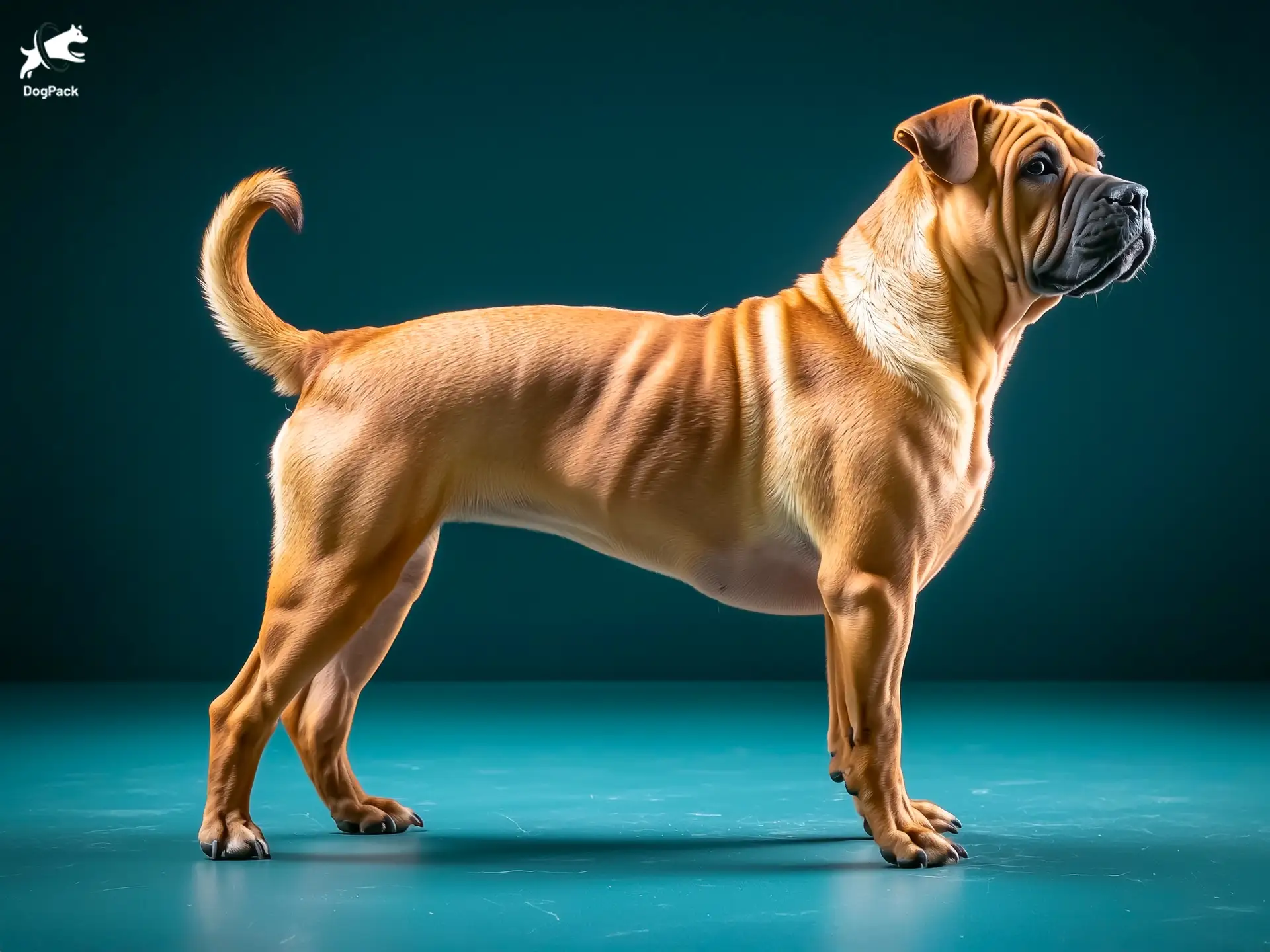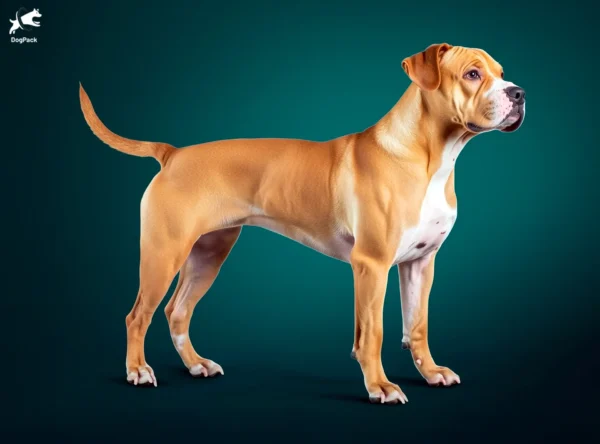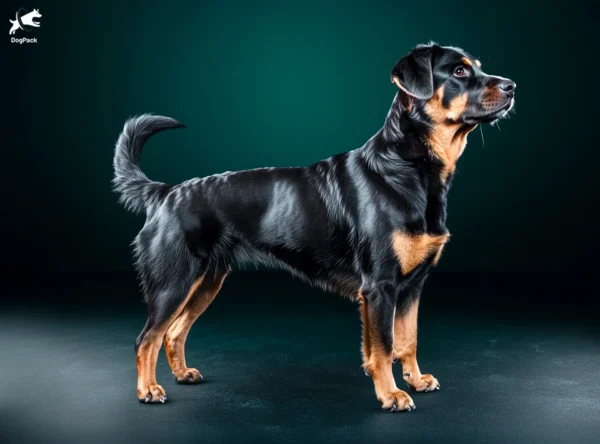Sharpull Terrier Dog Breed Info & Overview
The Sharpull Terrier is a striking crossbreed combining the protective instincts of the American Pit Bull Terrier with the distinctive wrinkles of the Shar-Pei. Known for loyalty, strength, and affection, this hybrid thrives as both a devoted family guardian and a playful companion. With proper training and socialization, the Sharpull Terrier offers the perfect mix of courage and heart.
Characteristics
Pictures
Breed History
Despite its modern-sounding name, the Sharpull Terrier began to appear decades ago in the United States. Breeders sought to combine the revered loyalty and protective instincts of the Pit Bull with the distinctive wrinkled appearance and steadfast courage of the Shar-Pei. Over time, this mix gained popularity in neighborhoods that valued both a faithful guard dog and a devoted companion.
Historians note that Shar-Peis trace back centuries in China, where they guarded homes and hunted. Meanwhile, the American Pit Bull Terrier has deep roots in old English bull-baiting dogs, though today it’s known for unwavering loyalty. Combining these lineages resulted in a strong, robust breed that many enthusiasts refer to simply as the Sharpull.
As hybrid dogs became more accepted, the Sharpull Terrier found its place among families seeking a unique pup with both a gentle side and a guarding instinct. Though not officially recognized by major kennel clubs, this breed has steadily garnered appreciation through word of mouth and local breeding programs, where admirers prize its balance of bravado and affection.
Temperament, Personality
A well-socialized Sharpull Terrier is often a loving companion that forms tight bonds with its family. They tend to be confident, thanks in part to their Pit Bull heritage, yet they retain the watchful eye inherited from the Shar-Pei. Early training and plenty of human interaction can help them grow into devoted pets that blend affectionate cuddles with vigilant guardianship.
These dogs typically do best in homes where they can be around people frequently, as they thrive on companionship. While they are good at setting boundaries, especially around strangers, a patient introduction process can help them warm up to visitors. Their confident nature suits owners who can meet that self-assuredness with calm guidance and consistency.
Children in the household often find a loyal friend in this breed, but adult supervision is essential to teach both kids and dogs how to interact safely. The Sharpull Terrier’s innate protectiveness extends to younger family members, yet respectful socialization is crucial. With ample positive reinforcement, these pups can become well-mannered members of both large families and smaller households.
Physical Characteristics
As you might guess from its Shar-Pei influence, one of the Sharpull Terrier’s most eye-catching traits is the folded or wrinkly skin around the face and neck. Their short, dense coat can vary in color, from solid black or brown to red or brindle. The Pit Bull lineage often imparts a sturdy, muscular frame that stands proudly and exudes confidence.
These hybrids are typically medium to large in build, with broad chests and strong legs that lend themselves well to an active lifestyle. Their ears can be slightly folded or even stand partly upright, depending on which parent’s genes dominate. Eye color also ranges, though darker eyes are most common, giving them a steady, discerning gaze.
Expect this breed to have a compact torso, a somewhat wide head, and a powerful jaw, much like the American Pit Bull Terrier. At the same time, subtle wrinkling adds a dignified presence reminiscent of the Shar-Pei. Though unique in appearance, these dogs wear their hybrid heritage proudly, blending two distinct ancestries into one strong, agile, and endearing physique.
Health Issues
Common concerns in a Sharpull Terrier can include skin irritations, especially around those distinctive wrinkles. Regular checks and cleaning of skin folds are crucial to prevent infections. Additionally, some individuals may inherit joint problems like hip dysplasia, a condition where the hip joint doesn’t form correctly, leading to discomfort. Early detection and routine veterinary care can make a significant difference.
Heart issues, such as congenital defects, can occasionally appear in this mix, as can conditions like entropion (inward-turning eyelids), more typical in Shar-Peis. Yearly checkups help ensure any arising issues are caught early. Responsible breeders will conduct health screenings on parents to reduce the risk of passing on genetic diseases.
For deeper insights on specific health risks, VCA Hospitals offers extensive resources on dog ailments, and PetMD provides additional guidance for managing breed-related conditions. Keeping your Sharpull Terrier active, maintaining a healthy weight, and scheduling regular vet exams can go a long way in preventing or mitigating serious health challenges.
Grooming Needs
Thanks to the short coat typically inherited from both parent breeds, the Sharpull Terrier doesn’t demand excessive grooming. A weekly brushing session can help remove loose hairs and distribute skin oils for a healthy shine. That said, those adorable folds need consistent attention. You’ll want to gently clean and dry any wrinkles at least once a week to ward off bacterial infections.
Bathing is usually needed every four to six weeks unless your dog finds extra messy adventures. A gentle, pH-balanced canine shampoo is ideal for preserving their sensitive skin. Extra care around the face and neck folds is especially important to rinse away trapped dirt. Nail trimming should be checked every couple of weeks, and ear cleaning will help prevent wax buildup.
Facial wrinkles might trap moisture, so keeping them dry is key for warding off hot spots. Many owners opt for gentle wipes or a soft cloth dipped in warm water to clean the folds. If you notice persistent redness or a foul odor, consult your veterinarian. With consistent grooming, a Sharpull Terrier stays healthy and comfortable while looking sharp—pun intended!
Exercise Requirements
Expect a moderate to high energy level from this muscular hybrid. A daily walk of at least 30 minutes, combined with play sessions, can keep your Sharpull Terrier content. They’re agile enough for activities like fetch or even light jogging—just be sure to watch for overheating, as their short muzzle can sometimes make prolonged intense exercise challenging in hot weather.
Mental stimulation is equally vital, given that both parent breeds are quite intelligent. Puzzle toys, obedience drills, or learning new tricks keep them mentally engaged, which helps prevent destructive behaviors born out of boredom. If you have a fenced yard, supervised playtime can serve as a great energy outlet while also reinforcing a sense of territory and security.
Social outings, such as dog-friendly hiking or trips to well-managed dog parks, can also benefit this energetic canine. Just ensure your pup has mastered basic commands and is comfortable meeting other dogs. For more info on incorporating exercise into your routine, check out our guide to large dog breeds that need ample physical activity. With consistent exercise, a Sharpull stays happy and well-adjusted.
Training Tips
Early socialization is everything with this breed, especially given the protective nature inherited from the Shar-Pei side and the strong will from the Pit Bull lineage. Enrolling your Sharpull Terrier in puppy classes or controlled social groups can help them learn appropriate interaction. Start with basic commands—like “sit,” “stay,” and “come”—and use positive reinforcement to nurture a responsive, confident companion.
Consistency is vital. Make training sessions fun and reward-based, as harsh methods can make these dogs distrustful or stubborn. Short, frequent sessions often work better than lengthy drills. If you find your pup getting overly protective, redirect focus onto a simple command or provide a treat-based distraction to signal calm behavior. This approach helps them adapt to new faces and environments.
Given their determination, some owners opt for professional obedience courses to fine-tune manners. Reinforcing boundaries, like furniture rules or greeting protocols, establishes a respectful dog-human relationship. For further reading, the AKC Training Resources offer valuable tips. With patient, consistent strategies, your Sharpull Terrier can become a well-behaved member of the family who responds eagerly to commands.
Nutrition, Diet
Because the Sharpull Terrier tends to develop a muscular frame, they benefit from a diet rich in high-quality protein. Look for foods with real meat (like chicken or lamb) as the first ingredient to support lean muscle. Many owners feed approximately 2.5 to 3 cups of premium kibble per day, split into two meals. This helps maintain steady energy and prevents bloat risks.
Some individuals may be prone to skin sensitivities, so choosing a grain-free or limited-ingredient formula can minimize allergic reactions. Additionally, incorporating omega-3-rich options, such as fish oil or salmon-based kibble, often helps keep their coat and skin in top shape. Always watch portion sizes, as these dogs can overeat if free-fed.
Puppies might require specially formulated large-breed puppy food that includes balanced calcium and phosphorus levels for controlled bone growth. As they mature, monitor their weight to ensure they stay lean and agile. Homemade diets should be carefully balanced in consultation with a veterinarian or canine nutritionist. Keeping your Sharpull Terrier on a well-planned meal schedule supports optimal health and longevity.
Adoption, Breeders
If you’re ready to adopt a Sharpull Terrier, start by checking local rescues or shelters, where bully and Shar-Pei mixes occasionally become available. Always inquire about the dog’s background, temperament, and medical history to ensure a good match. You can also connect with owners and find rehoming opportunities in the Sharpull Terrier Facebook Group for breed-specific advice.
For those set on buying from a breeder, search for small-scale programs that prioritize health and temperament. Reputable breeders will share health clearances and encourage you to visit their facilities. Always ask for proof of genetic testing on both parent breeds, such as hip and eye screenings. Early socialization and transparency are key signs you’re dealing with a breeder who genuinely cares for their dogs.
Be cautious of online ads promising rare or unusually cheap puppies without offering proper documentation. Avoid high-volume breeders who may neglect important health practices. A responsible breeder or a reputable rescue will provide guidance, health records, and ongoing support. Taking the time to choose carefully ensures you’ll welcome a Sharpull Terrier that’s healthy, well-adjusted, and ready to become part of your family.
Family Pet?
Families with children often find a loyal playmate in this breed. Supervised interaction, particularly with very young kids, ensures everyone stays safe and comfortable. A Sharpull Terrier typically bonds closely with family members, happily joining group activities or cuddling on the couch after a busy day. Their protective streak may be strong, but they usually balance it with gentle affection at home.
They can adapt well to a multi-pet household if introduced properly. Early socialization will help them accept other dogs and even cats—though smaller animals should be introduced cautiously. Teach kids about dog body language and the importance of respecting the dog’s space to foster a peaceful environment.
A consistent routine, regular exercise, and stable leadership usually bring out the best in this family-friendly companion. These dogs enjoy interactive play and might even thrive with older children who can participate in their training. For guidance on dogs that do well in homes with kids, check out our dogs for families category. When well-trained, a Sharpull is an affectionate protector for everyone in the household.
Right For You?
IIf you crave a confident, protective companion that blends a loving nature with a bit of stubborn streak, the Sharpull Terrier may suit you. Owners who have time for consistent training, daily play, and careful socialization will likely enjoy this loyal mix. Those seeking a lower-energy lapdog or who cannot accommodate regular exercise might find this breed too demanding.
Because of their size and protective instincts, these dogs often do best in homes with outdoor spaces, though apartment living isn’t impossible if daily walks are guaranteed. Before bringing one home, consider your readiness for ongoing grooming (especially around wrinkles) and vigilant health checks. If a balanced blend of gentle affection and watchful loyalty appeals to you, this dynamic breed might be a perfect fit.
Be prepared for a learning curve if it’s your first time with a strong, spirited dog. However, the bond you develop can be incredibly rewarding. For additional insights on how different breeds fit into active lifestyles, browse our American dog breeds section. With proper care and consistent leadership, a Sharpull Terrier can flourish in the right home environment.
Conclusion
In essence, the Sharpull Terrier merges the Shar-Pei’s steadiness with the Pit Bull’s undeniable devotion, creating a strong yet surprisingly affectionate pet. Families and dedicated individuals willing to invest in training, exercise, and grooming will discover a companion who offers loyalty, protection, and wrinkly charm in equal measure. Consider welcoming this devoted canine into your life if you’re up for a confident, loving partner.
FAQs
-
What is the Sharpull Terrier’s guarding style like?
The Sharpull Terrier is naturally protective but tends to show quiet vigilance rather than excessive barking. They often assess situations calmly before reacting, making them loyal and steady home guardians without being overly noisy.
-
Do Sharpull Terriers show strong problem-solving skills?
The Sharpull Terrier combines the Shar-Pei’s independence with the Pit Bull’s intelligence, resulting in a dog that often demonstrates creative problem-solving. They can figure out puzzles or situations independently, which owners may notice during play or daily routines.
-
How does the Sharpull Terrier handle meeting new people?
The Sharpull Terrier can be reserved with strangers at first, reflecting their Shar-Pei lineage. However, with proper socialization, they typically warm up and become friendly, especially when introduced gradually and respectfully.
-
Is the Sharpull Terrier suitable for first-time dog owners?
Due to their strong-willed and sometimes stubborn personality, the Sharpull Terrier is better suited for owners with some dog-handling experience. Consistent, confident leadership helps this breed thrive and show its affectionate side.
-
Do Sharpull Terriers enjoy having a job or task?
Yes, the Sharpull Terrier thrives when given a clear role or task, such as obedience, scent games, or agility. This working-dog mindset helps channel their energy positively and deepens their bond with their owner.
Breed Ratings
The Sharpull Terrier demonstrates keen problem-solving abilities and learns commands quickly with consistent training.
They enjoy games and activities but may also appreciate quiet time with their families, balancing both sides well.
Expect moderate-to-high energy, making daily walks and play sessions essential for a well-adjusted companion.
Short coats shed moderately, requiring regular brushing to manage loose hair and keep them clean.
They can have a fair amount of prey drive, so early socialization is crucial when introducing smaller pets.
Basic brushing is simple, but skin-fold upkeep requires routine cleaning to avoid infections.
Eager to please yet sometimes stubborn; consistency and positive methods yield the best results.
They form strong attachments and can experience separation anxiety if left alone for long periods.
Generally moderate, they’ll alert you to unfamiliar activities, but aren’t constant barkers.
Some drool may occur around the jowls, especially after drinking or playing, but it’s not excessive.
With socialization, they can get along with other dogs, though they may be cautious initially.
Overall health is good, but regular vet checks are key to catching any skin, joint, or eye issues.













